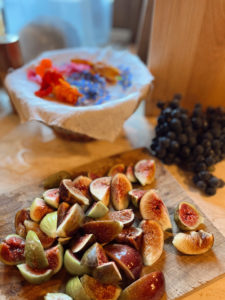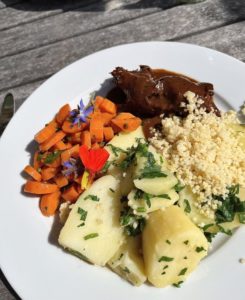Winter is upon us. If you're tucked away in the Pacific Northwest corner of the States like I am, that means another 4-5 months of soup season. Days are short, rain is steady, and the bright, fruit-forward flavors of summer have faded into a distant, sultry memory. It’s the season of donning our waterproof shells and thick wooly socks. And, if you’re of the gardening variety, you’re in for a wholesome winter harvest of chicory, endives, radishes, swiss chard, rutabaga, mustard greens and leeks.
As winter deepens, our food preferences naturally and psychologically change with it. The human body is miraculously hardwired to crave and eat foods that keep us warm and full during colder months. With the outdoor grill turned off, we find ourselves gravitating towards our indoor crockpots and ovens. Our bodies are asking us, telling us, to eat with the seasons. To fuel up during the winter months, regulating our internal temperature with foods that warm and nourish us.
The key to local + seasonal
Tuning into the seasons allows us to engage with food in a deeper, richer way. This awareness also invites a rooted sense of place, where we become aware of and even celebrate the foods local to our geographic environments. And when you combine what’s seasonal with what’s local, you get the freshest flavor. This means a guarantee that your food didn’t take a cross-continental road trip (bolstered with preservatives) to arrive at your grocery store. It also means that your food bears witness to where you live, telling the story of local farmers and growers who are dedicated towards offering you the region’s hallmark, most natural flavors.
The garden’s ripest and brightest

It wasn’t until I booked a one-way ticket to Europe this past summer that I truly understood the significance of eating locally and seasonally. After months of exploring Swiss, Austrian, German, Dutch and Danish flavors, I spent September living with two vegan chefs in the heart of Tuscany’s Arezzo region. That's where I witnessed hyper-local and seasonally-expressive cuisine on display. We passed the early autumn days harvesting food from the garden, mushroom hunting and cooking meals that touted Tuscany’s best. The ripest and brightest ingredients were main characters in our shared meals, and whatever the garden lacked we sourced from local producers. It was a slow, intentional practice of place-ful eating. I learned to curb my cravings for non-regional foods, and enjoyed the (almost meditative) practice of eating what was available, seasonal, and true to the region.
Bold, regional flavor
The local-centric, seasonal lifestyle around food I witnessed in Tuscany (and a number of other European countries) struck a chord in me. I wanted to understand what made freshness the key ingredient to so many of the dishes and homemade meals I enjoyed, specifically in Italy. What I witnessed and learned is that authentic Italian cuisine involves simple ingredients, largely dictated by climate and natural landscape. The flavors emblematic of Italian food culture pay homage to regional accessibility and seasonal availability. You won’t find an Italian snacking on fresh tomato bruschetta in January, or cooking up zuppa di castagne e ceci (chestnut and chickpea soup) in July. When your main ingredients boast bold regional flavor, it’s about maximizing those ingredients and letting the food speak for itself.
Location laws and unruly food additives
Location plays such a critical role in Italian food production that Italy has passed a number of laws to protect the authenticity of products made in particular regions. And, speaking of laws, according to the New World Report, the European Food Safety Authority (EFSA) doesn’t allow additives in food production unless they’ve been proven to be unharmful to human consumption. The FDA has taken a different, more reactive approach in the States, where food additives are allowed into food production until they’re proven to be directly harmful to consumption. This means that food in the U.S. is not only likely to contain GMOs, but also foods rich in growth hormones and chemical preservatives to ensure a long shelf-life for our out-of-season eating habits and cravings. Not so in the larger European narrative around food, where (generally speaking) seasonal rhythms and locality play critical roles in the enjoyment of food closer to its origin and peak freshness.
Take it from the Italians – Eat local and seasonal foods
On one hand, prioritizing local and seasonal food products allows you to bypass highly processed foods that tend to be low in nutritional density. When food products are engineered to withstand time and travel, you can bet that nutritional saliency takes a hit. According to the Center for Food Safety, about 70-80% of processed foods in the U.S. contain GMOs. So, eating seasonally and buying locally-produced food as much as possible helps you shop with confidence, knowing that your food was made as nature intended, not bioengineered in a lab. You’re also reducing environmental impacts by choosing organic, non-GMO and local products. Less food transportation = lower carbon footprint. And, you’re keeping money in your local community by supporting producers and growers in your area. Finally, farm-fresh, locally grown food picked at peak ripeness is JAM-packed with flavor.

When it comes to winter in a maritime climate, we all need our seasonal survival strategies. Since leaving Tuscany’s warm, Mediterranean embrace and expressively fresh, regional cuisine, I’ve been seeking out ways to enjoy the winter harvest in my Pacific Northwest home climate. Knowing what’s in season has been the simplest way to add more local freshness to my diet. Italy’s winter harvest is actually very similar to that of the United States, with squash, mushrooms, cabbage, lentils, and clementine and mandarins in full bloom. Another method to access local, seasonal foods is through community supported agriculture (CSA) programs, where fresh produce is sourced from farmers local to your area. CSAs allow you to learn about fruits and veggies you may not have chosen at the grocery store, expanding your food horizons and palette preferences. And, winter farmers markets offer local and seasonal produce that’s readily available and assuredly delicious.
Escaping winter’s doldrums with fresh flavor
Even during these chilly months, there’s time to begin exploring a varied seasonal diet. Seasonally-bound and locally-based menus have the power to pull us from winter’s doldrums and feel connected to the place we’re in. Specifically in the Northwest, our seasonal rains and comparatively mild winters support cool-season crops even after the first frost. The winter harvest is robust and ready with flavor to nourish, sustain, and delight, even in the chilliest of seasons.
(Pro tip! Next summer, take a moment to remember the dark, languid days of winter ahead. Flash freeze your summer harvest of blueberries, strawberries, peaches and raspberries. Then, on a cold winter’s night when you need a zing of summer, whip out those frozen berries and make yourself a ripe, tart treat.)
*Photos courtesy of the author
 Guest writer: Madi Burke. As a writer, explorer, and incessantly curious person, Madi Burke has always felt passionate about the natural world, our lived environments, and how to create more equitable systems that bring people closer to the nourishment and quality of life that comes with an integrated relationship to the earth. After receiving her undergraduate degree in sociology and speech communications, Madi went on to lead cycling trips in national parks, support nonprofit development, and now gets to help organizations tell their story as a freelance writer and brand manager.
Guest writer: Madi Burke. As a writer, explorer, and incessantly curious person, Madi Burke has always felt passionate about the natural world, our lived environments, and how to create more equitable systems that bring people closer to the nourishment and quality of life that comes with an integrated relationship to the earth. After receiving her undergraduate degree in sociology and speech communications, Madi went on to lead cycling trips in national parks, support nonprofit development, and now gets to help organizations tell their story as a freelance writer and brand manager.
